Yamaha Possible Coverup of Propeller Guard Documents Exposed
The boating industry has long defended itself in propeller injury court cases by claiming propeller guards don’t work. Among their objections, the industry claims guards create too much drag, reduce performance (top speed), effect the handling of the boat, are not durable enough, get bent into the propeller, and they create blunt trauma injuries when they strike people.
But Yamaha was making the exact opposite statements about their propeller guard. Yamaha said their guard worked great, minimized drag and performance reduction, improved handling, was strong and durable for use in shallow water, and guards were essential for operating rescue boats near people in the water.
Our mid October 2012 posts echoed several of Yamaha’s own comments.
By early November 2012, everything Yamaha ever said about the propeller guard AND all records of the guard’s existence vanished from their website. We made many attempts to contact Yamaha about why they pulled all of their materials about the propeller guard, but they will not respond. That leaves us to suspect Yamaha erased their statements to protect the boating industry’s long standing legal defense, “Guards don’t work”.
Among the many specific statements made and deleted by Yamaha about their propeller guard were:
- “a new design of propeller guard, shaped to give greatest strength, with minimum water-flow disturbance to the propeller giving maximum performance when required.”
- “For shallow and unpredictable conditions, a Plastic Prop Guard or stainless steel Deflector Guard will assist in limiting the chance of foreign objects fouling the propeller. In addition, these guards aid control of water flow from the propeller and can increase thrust at low RPM.”
- Yamaha propeller guards, tailored to fit individual engines, are also specifically designed to have minimal impact on performance.”
- “When operating in a flooded environment there is also the possibility of casualties in the water, which means a propeller guard is essential to reduce the risk of injury.”
- “When operating in flooded environments the liklihood of swimmers/diver/casualties being in the water means that a prop. guard is essential.”
We dare the boating industry trade press to cover this important story. Don’t let the industry banish this life saving propeller guard just to protect themselves in court.
We need some help. We call upon:
- The press to cover this story, especially the boating press.
- Boating safety organizations and the United States Coast Guard to take action to prevent Yamaha from further suppressing this technology.
- The legal and judicial system to prevent Yamaha from destroying test data from which they claim this was the best propeller guard they ever tested.
- The boating industry itself to do what is best for the safety of their customers and put some peer pressure on Yamaha to do the right thing.
- Our fellow propeller safety advocates to help get the word out.
Below we provide details of the events surrounding Yamaha’s deletion of these materials.
History of Yamaha’s Propeller Guard / Propeller Deflector and Their Own Statements About the Guard
About October 2012 we noticed Yamaha UK Pro was outfitting small outboard powered rescue boats (Rigid Inflatable Boats or RIBs) with a new vane type propeller guard.
Yamaha spoke very highly of this new stainless steel propeller deflector in their press releases and literature for the rescue outboards.
We posted a series of articles on the new guards and Yamaha’s statements about how their propeller guard overcame several of the previous objections to propeller guards and how propeller guards were essential to reduce risk to people in the water in rescue situations. We posted the three articles, one each day on October 13, 14, 15, 2012.
- Yamaha Offers Propeller Guards on UK Pro Outboards. October 13, 2012.
- Propeller Solutions Launches Nylon Coated Stainless Steel Propeller Guards. October 14, 2012.
- Yamaha Motor UK Pro says “a propeller guard is essential to reduce the risk of injury. October 15, 2012.
Then in early November 2012, just one day before the U.S. Coast Guard National Boating Safety Advisory Council (NBSAC) was to be held, we noticed every reference to the new propeller guard had been removed from Yamaha UK Marine’s website.
The next day, 9 November, 2012, we posted an article asking Yamaha to explain why all these references were withdrawn. They have not responded.
At the November 9-11, 2012 USCG NBSAC Meeting in Watsonville, California, one of our fellow propeller safety advocates, Marion Irving deCruz of SPIN (Stop Propeller Injuries Now) spoke publicly at the meeting and noted the unusual disappearance of Yamaha’s materials surrounding this new propeller guard. The NBSAC meeting was attended by very high level Yamaha executives, but they too have not responded.
After we continued to receive no response, on November 12, 2012 I attempted to contact Mark Pullinger, the UK Yamaha Marine marketing executive that put the flood rescue outboard package together, via LinkedIn but he would not respond.
After no response from Mark Pullinger, on November 21, 2012 I attempted to contact Martin Peters, Manager of Communications for Yamaha Marine US via email, but he too would not respond.
Our message to Mr. Peters re-iterated our hope that these materials had been pulled down for updating them or some other purpose than to remove them from public view for legal concerns (banishing Yamaha’s own bold statements about how great this propeller guard is).
Our November 9, 2012 post asking Yamaha to tell us why they removed all references to the propeller guard from their web site has been visited many times by several Yamaha divisions around the world. None of them have responded.
On January 2, 2013 as we were finishing this post, I came across a direct email address for Mark Pullinger at Yamaha UK. I emailed him about 2pm January 2nd, informed him we would be publishing an article critical of Yamaha’s deleting of the materials about the propeller guard if someone did not respond to us by 1pm Central time on January 3rd with why the materials were all deleted. The email also made it clear that Yamaha’s explanation would have to be in compliance with the facts. I told him of my admiration for Yamaha, thanked him for his work on the project, and expressed my frustration with Yamaha not responding to any of our many inquiries. On the morning of January 3rd, we could see my email sent yesterday to Mark Pullinger at Yamaha had been received and they had visited the link I supplied to our November 8, 2012 article announcing Yamaha had removed materials about the propeller guard from their site. But, they too did not respond.
Late January 3, 2013, in the absence of any response from Yamaha to the request on our website, to SPIN’s plea at NBSAC, to our LinkedIn message to Mr. Pullinger, to our email to Mr. Peters, and to our January 2 direct email to Mark Pullinger, we posted this article. We are left to believe what we had hoped not to be true. Yamaha appears to have erased all these documents from public view in fear of potential legal implications (how can Yamaha’s propeller guard be great when the boating industry’s legal defense is “propeller guards don’t work”). And according to Yamaha’s now missing statements, not only do these guards work, but propeller guards are essential when people are in the water near the boat.
Yamaha’s failure to respond to our many inquiries also leads us to believe they think no one outside Yamaha has copies of the many documents they deleted.
Exactly What Did Yamaha Delete From Public View?
A list of some of the changes to Yamaha’s web site between October 15, 2012 and November 8, 2012:
- Yamaha Motor UK news page removed “Professional and commercial users now…” 21-05-2012 from the list of news items
- Yamaha Motor UK removed the “Professional and commercial users now Powered by Yamaha in the UK” 21-05-2012 page (partially posted below).
- Yamaha Motor UK removed “Lincolnshire Fire & Rescue receive new flood rescue equipment from Yamaha Motor (UK) Ltd.” 28-03-2012 press release from its “Yamaha News” (partially posted below).
- Yamaha Motor UK removed the 2 Stroke Flood Rescue Engines four page pdf brochure (partially posted below)
- Yamaha Motor UK removed the Outboard Pro User Accessories two page pdf brochure (partially posted below)
- Yamaha Motor UK 25NMHOL/S outboard html brochure page removed “prop guard” from list of available options
- Yamaha Motor UK 90AETOL outboard html brochure page removed “prop guard” from list of available options
Copyright Issues
We recognize we are reproducing portions of materials copyright by Yamaha below. This is done under the “Fair Use” doctrine. We are only reproducing enough to prove the comments we attribute to Yamaha were actually made by them AND to prove to Yamaha and the boating industry that we have full copies of these documents. We chose to publish excerpts to keep more in line with the “Fair Use” doctrine. We did not alter them, other than to redline certain areas and clip out certain areas to limit the percentage of the individual documents we reproduced.
In reality, they are press releases and brochures intended for distribution. If Yamaha would like us to further limit the portions reproduced, please contact us and we will try to work together on your request.
Copies of the Propeller Guard Documents Yamaha Deleted From View
Yamaha may think they have forever hidden those statements from the light of day, but they are wrong. We have full, high resolution, dated copies of each of the documents listed above (and more). Just so they and the industry know we are not bluffing we are posting portions of some of those documents below.
Yamaha Motor UK “Professional and commercial users now Powered by Yamaha in the UK” 21-05-2012 page 1 of 2 page press release
Yamaha Motor UK “Lincolnshire Fire & Rescue receive new flood rescue equipment from Yamaha Motor (UK) Ltd.” 28-03-2012 press release. The associated images were not reproduced below.
Yamaha Motor UK removed the 2 Stroke Flood Rescue Engines brochure
Page one of the four page 4.2 MB pdf brochure is below. It is followed by a portion of the top of page 3 of the same brochure.
Yamaha Motor UK Outboard Pro User Accessories brochure
Page one of the two page pdf document is shown below.
Web Site Logs Show Yamaha Viewed Our Articles on the Propeller Guard
We retrieved and studied our web logs. They indicate Yamaha US found our three articles covering their guard two days after we posted the third one. Yamaha US in Cypress, California found the articles about 5 pm Central DST October 17th, 2012. Then Yamaha US, Yamaha Japan, and Yamaha Netherlands were buzzing all over them just a few hours later. A few days later, Yamaha UK joined in. We charted their visits in as Gantt chart. Click on the chart below to view a larger pdf version.
Just so you know we are not making this up, we are providing copies of portions of our site logs for October 17 and October 18, 2012.
Our pages about the guard have since been visited by other Yamaha sites around the world.
Comparing the site logs shows the U.S. found the articles. They came to our site from a Google search to our page on the U.S. Coast Guard’s Public Service Announcement (PSA) “Don’t Wreck Your Summer”, and noticed the link to our first Yamaha article in the side bar (Yamaha Offers Propeller Guards on UK Pro Outboards). They clicked on the link to that story then began to explore the others. Yamaha Japan was alerted to the articles by someone (probably Yamaha US because they did not come in by a search engine), then Yamaha Netherlands was alerted by someone (probably by Yamaha Japan because Yamaha Netherlands did not come in by a search engine and Yamaha US was probably asleep at that time – or maybe Yamaha Netherlands came in from a Yamaha US email sent many hours earlier).
There is absolutely nothing wrong with Yamaha visiting our web site. In fact, we encourage Yamaha and others in the industry to frequently visit our site. We summarized and posted our logs merely to prove Yamaha was aware of us calling attention to their own statements about these propeller guards between the time we posted the articles and when Yamaha deleted all references to the propeller guards approximately two to three weeks later.
They Were Talking About Rescue Boats
We want to make sure everybody understands that Yamaha’s comments were made in the context of rescue boats, not recreational boats. We were just struck by the same comments being made in the behalf of propeller guards for rescue boats that were typically made against propeller guards on recreational boats and trying to reconcile the comments with the boating industry’s actions. The success they were enjoying on rescue boats looked tantalizingly replicable on at least some recreational boats
Yamaha Hides the Statements From the Public While Showing the Flood Rescue Outboards at ESS 2012
Yamaha removed all online references to their new propeller guard on or prior to 8 November 2012. However, it looks like they showed the flood rescue outboards (presumably with the guards attached) at a major Emergency Services show in the UK on November 21-22 (The Emergency Services Show at Stoneleigh Park in Coventry). We noticed a Flickr image from a group of photos of The 2012 Emergency Services Show that appears to show one of the red Fire And Rescue outboard covers similar to those used by Linconlshire Fire and Rescue.The red slip on covers are part of Yamaha’s flood rescue outboard package. We downloaded a high resolution image of the photo, cropped out the area of the apparent outboard cover, removed some noise, and sharpened the image. As seen below, it appears to be one of the outboard covers. It has the same gray stripe, and appears to say “Yamaha” below the stripe. They just left off the “Lincolnshire” line at the top and printed them in a more standard font.
It sure looks like a flood rescue outboard cover to us. In retrospect, it looks like the more generic red cover Yamaha used on the cover of its 25 & 40 HP Rescue Outboard brochure above. If its a flood rescue outboard at an emergency services show, we are left to assume the propeller guard was mounted on it. Did any of our viewers see it?
Just before posting this article, we discovered Yamaha discussing the products they intended to show at ESS 2012 in the October 2012 special issue of Emergency Service Times. Yamaha specifically mentions planning to show the flood rescue outboard and the propeller guards. That pretty much confirms what we observed from the photo (and another photo of their trade show booth we found later).If this is true, it just adds insult to injury. Yamaha pulls the statements from public view while still selling the guard (Yamaha wants to make money from selling the package, but doesn’t want the liability for the favorable statements they made about it).
Deleted Comments off Supplier Web Sites
The apparent supplier of the guards to Yamaha or at least marketers of the same guards (we are not directly mentioning them here because we don’t want to drag them into the discussion) also sells the “Yamaha” propeller guard on boatsandoutboards and on eBay. Back in October those listings included quotes like this one:
“When tested by Yamaha UK with a Power Tech prop they found it to be the most efficient guard they have ever tested.”
Yes, we captured dated copies of those sites too. Now (January 2013), their listings on the same sites no longer include that quote. We suspect Yamaha asked them to delete it.
Look What They Were Saying in Court
We pulled the complaint and Yamaha Motor USA’s response to that complaint in William Coxe III vs. Yamaha Motor USA, et al. from PACER (Public Access to Court Electronic Records). I cropped the questions and responses from the respective documents and reassembled them in order so you can see Yamaha’s response right below the statement made by the plaintiff. In Coxe v. Yamaha the operator was ejected from a boat that circled and struck him very severely with the propeller.
The statements above were made in a Yamaha USA document filed in US District Court on March 1, 2012.
In this document Yamaha denies they knew “an outboard motor propeller presented a hazard of significant injury and death to persons and marine life” prior to the Coxe accident.
Yamaha denies “there is a statistical certainty that, from time to time, outboard motors will come into contact with persons in the water” prior to the Coxe accident.
Yamaha denied several more points.
Yet, in a March 28, 2012 press release featuring their new propeller guard and its associate marketing materials Yamaha made statements like:
“When operating in flooded environments the likelihood of swimmers/diver/casualties being in the water means that a prop guard is essential.”
Plus why did they even create a propeller guard if propellers don’t strike people in the water?
Yamaha tried to have it both ways (propellers are not dangerous, people do not come in contact with them) when in court, then sell guards and tell you how safe they make your boat in the marketplace.
In addition, we thought it was interesting that in this same case, Maverick Boat Company (manufacturer of the boat in the Coxe accident) answered the same questions in the complaint. Maverick said
Maverick Boat Company responded:
“boating involves certain open and obvious hazards including falling overboard and being struck by a moving boat or propeller and that the risk presented by these hazards are foreseeable to boaters and manufacturers alike.”
There is a strong tie between Maverick and Yamaha in part because Maverick bought Cobia boats from Yamaha back in 2005 and Maverick only sells boats with Yamaha drives (probably a condition of the Cobia deal). At any rate, the builder openly admits you can fall out and be struck by a prop while Yamaha denied they knew there was a statistical certainty that operators that were thrown overboard may be struck by their own propeller, prior to the Coxe accident.
What Do You Think?
Did Yamaha respond to our October 2012 articles by deleting all information surrounding their new propeller guard in an attempt to cover themselves in court? Was Yamaha pressured by the boating industry to remove the statements? Did Yamaha show the guard at ESS 2012? Is this a coverup? Or was the guard project shelved? Or is this all just a miscommunication? What do you think? We welcome your comments and we especially encourage comments from Yamaha that could quickly clear up this entire matter.
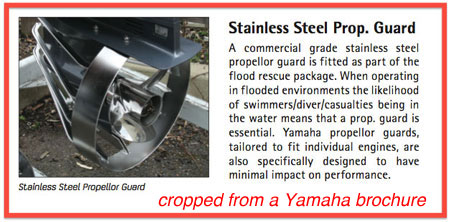
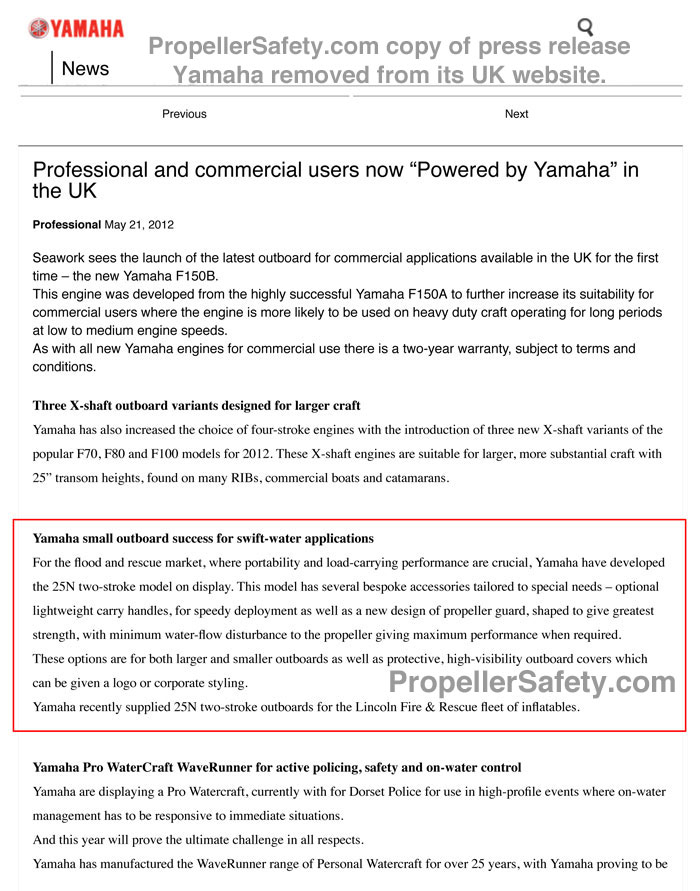
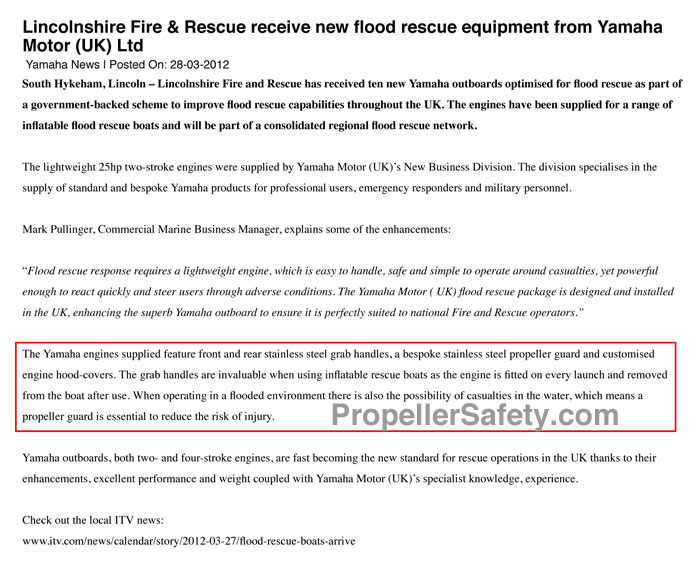
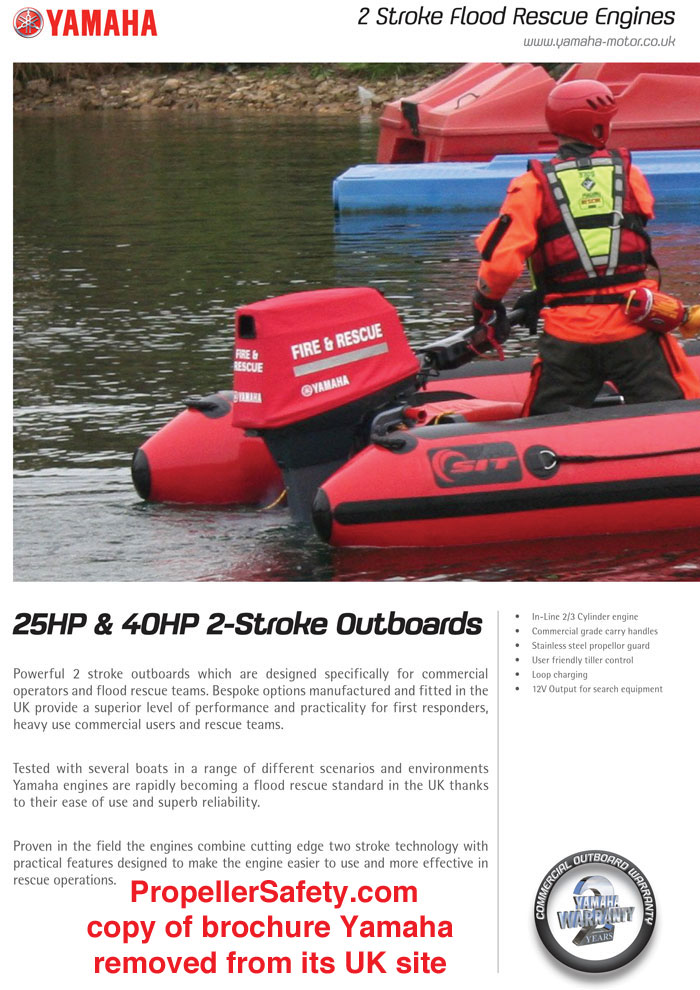
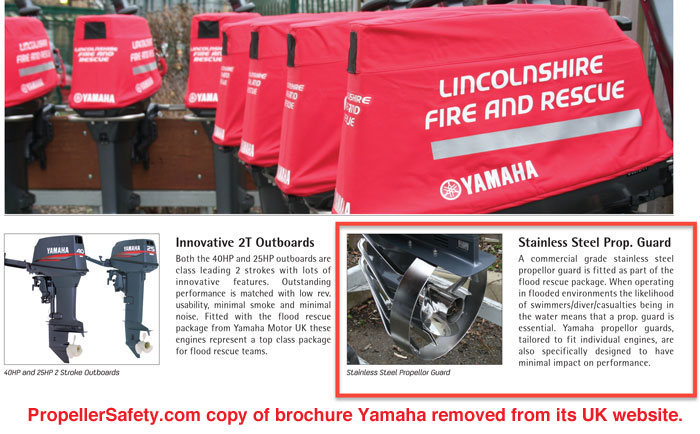
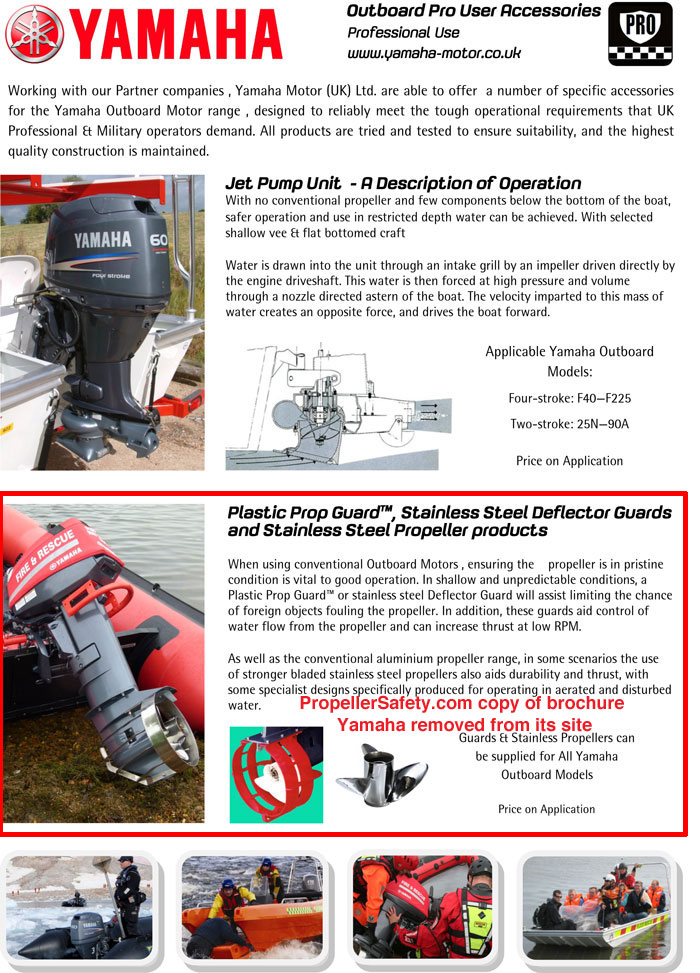
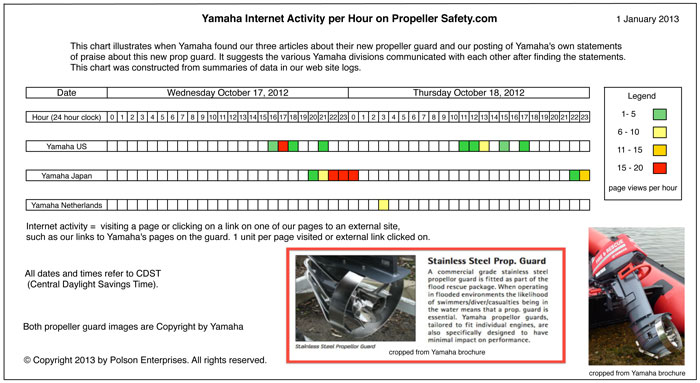
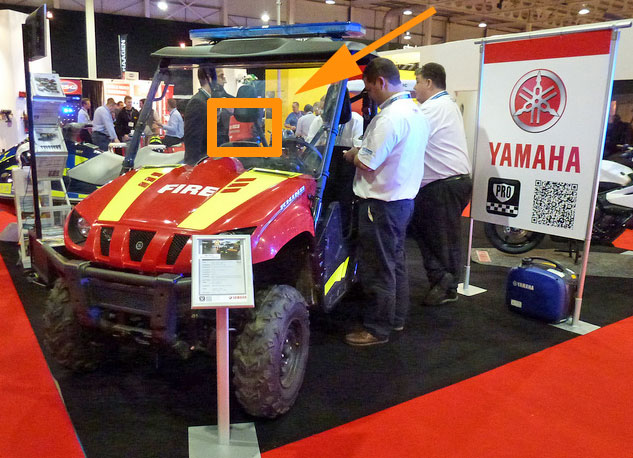
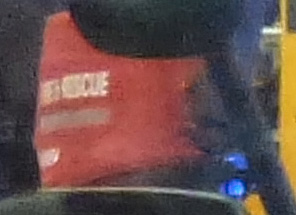
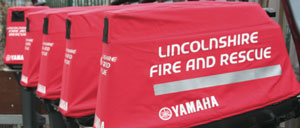
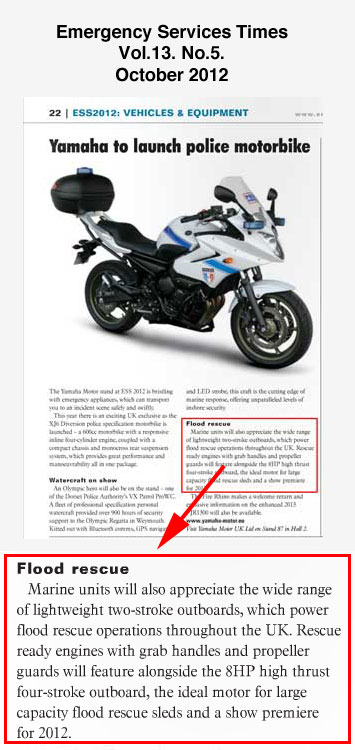
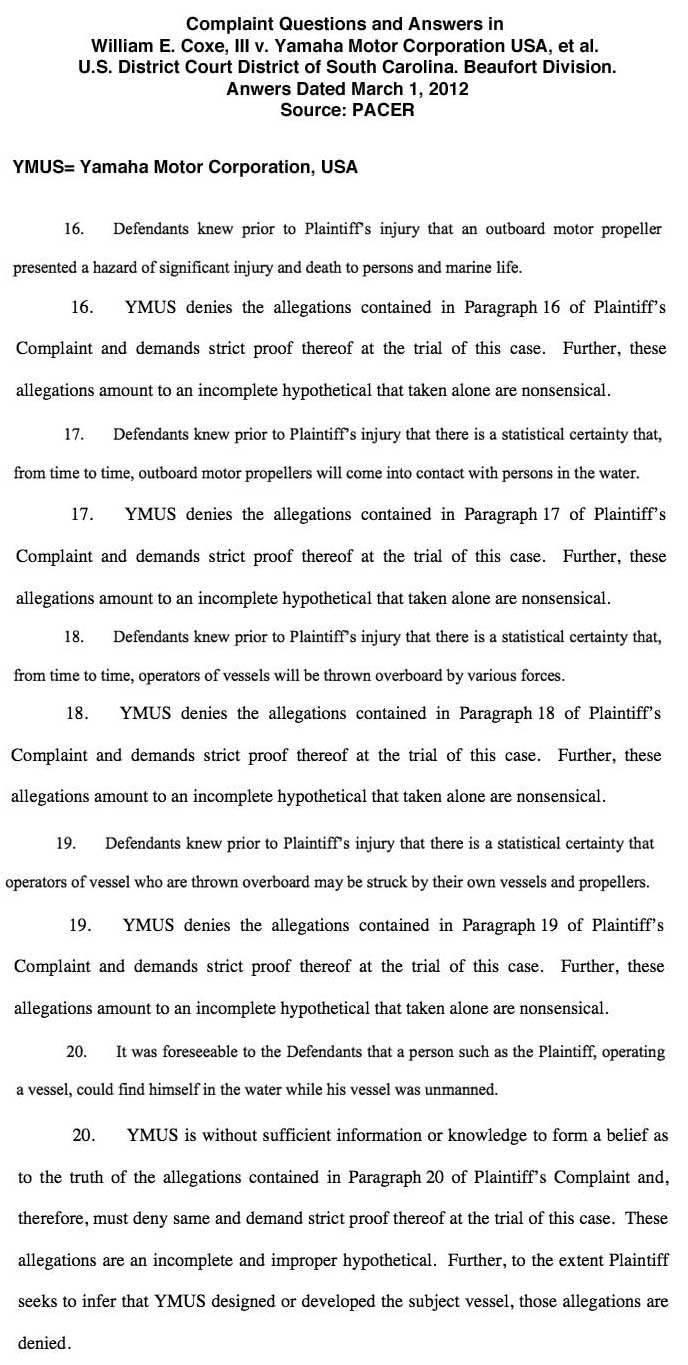
Thank you for a most informative article. I agree completely with your information. As a boat designer and builder, I have often wondered as to prop safety in this high tech. era. The prop guard normally shown, has not to my eyes been so successful in holding up to shallow water impact. The guard or any previously damaged pieces can also be dangerous, to any body parts being pulled into the impeller. The strength of any protection device might be questioned, when first subjected to the impact of underwater structure, fallen logs, old cars, fallen wires, or any flood debris that could snag at appreciable speed.
People do not maintain safety devices as purchased and designed, there is always an idea to “improve” what is offered properly, or there are moving parts that will not be maintained as specified. Second or third owners complicate the issues, in removing or not servicing critical parts then not knowing or caring about their use, until something goes wrong. One example is the guy falling overboard from his own moving boat. Could unchecked steering cables, or worn parts be at fault? Did he first hit a log standing up, or just try standing (raising the weight mass) to see how tight it would turn for fun ? Going over the side means he was not seated during powered moving, that is not a prop problem, is it ?
I am powering my next electric boat with a twin motor system, and looking at protecting the twin motor “pods” from damage under water. There is also a definite wish to make it safer from a swimmer standpoint, so several areas were to be addressed by me that your posts make a lot clearer. Thank you for the posted photos of the original Yamaha device. I have been inspired to use that as a guide for creating a much more suitable motor guard. I believe a better guard is possible, and I have the design experience with the shop ability to address that for the boat in construction now. Thanks for an excellent insight into the problem.
Great articles, I have been looking for this, Cal Drake
Thanks for your response. In today’s Internet world we often see 1 to 3 word responses. Its nice to see someone put some thought into it.
As to broader issues that can end up in propeller strikes and broader prevention strategies we have a Mitigating Boat Propeller Injuries and Fatalities chart.
Please share your guard design with our viewers once you get it built.
Good luck with your project.
gary
Thank you for sharing an informative article. Most people do not maintain safety equipment as designed and purchased. They will not maintain the moving parts or try to improve from what has been offered properly. Prop safety is one of the important things that should be focused in this present generation.
Holy cow that was a GREAT write up!
Lots of learning has occurred.
Thank you for putting this out. It’s 2023 and the world has changed since 2012 when I was in the Air Force. (Had a little RIB then too.)
I came across this while doing some looking at prop guard designs.
Stay safe!